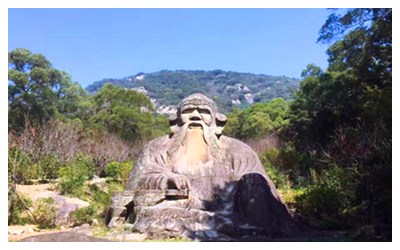Skype: neodalle-travel
Tel: +86 135 7447 2266
E-mail: sales@visitaroundchina.com
 Qingyuan Mountain Scenic Area lies in a northern suburb of Quanzhou city. It combines natural beauty with the religious cultures of Buddhism and Daoism. Walking along the trails, you'll be charmed by the various streams, ponds, and strange-shaped rocks. The mountain boasts thousands of ancient trees which make it green all year round.
Qingyuan Mountain Scenic Area lies in a northern suburb of Quanzhou city. It combines natural beauty with the religious cultures of Buddhism and Daoism. Walking along the trails, you'll be charmed by the various streams, ponds, and strange-shaped rocks. The mountain boasts thousands of ancient trees which make it green all year round.Qingyuan Mountain Scenic Area is comprised of three mountains-Qingyuan, Ling and Jiuri. The most appealing attractions here are the Statue of Lao-tzu; the Statues of the Three Buddhas; the Islamic Holy Tombs and the Qi Feng Inscriptions of the Song Dynasty (960 - 1279).
The Statue of Lao-tzu is on the left peak of Mt. Qingyuan. Lao-tzu was a famous philosopher and thinker in the Spring and Autumn Period (770 BC - 476 BC) as well as the founder of Taoism. His most renowned work is the 'Tao Te Ching' and is regarded as the basic doctrine of Taoism. His statue is considered one of the finest expressions of stone carving art in the Song Dynasty. Lao-tzu's left hand rests on his left knee and his right hand on a small table. His face is somewhat exaggerated with a pair of bright eyes, long eyebrows, a mustache and two oversized ears. It seems that he has seen through the vanity of the world and his face beams with happiness. This statue is the biggest extant stone sculpture of Lao-tzu measuring 5 meters high and 8 meters wide.
The Statues of the Three Buddhas (Tibetan Buddhism) stand in the Bixiao Grotto on Mt. Qingyuan. They were built during the Yuan Dynasty (1271-1368). The three Buddhas are set in a rectangular niche and each sits on a lotus flower throne. In the middle is Sakyamuni with his right hand touching the ground. On the left is Dipamkarara who has an alms bowl in his left hand. On the right is Maitreya who sits in meditation. All three Buddhas exemplify the fine carving skills of Yuan Dynasty artisans.
The Islamic Holy Tombs on Mt. Ling is the best preserved and the oldest existing Islamic site in China. The two tombs were built for two famous disciples of Muhammad (about 570-632), the founder of Islamism. Both of the covers of the tombs are sculpted in granite. In front of the tombs is a huge stone that wobbles when the wind blows or when people push it slightly. There are U-shaped cloisters about 3 meters high at the rear of the tombs. Here one can see five steles and several prism-like stone columns reflecting the style of the Tang Dynasty. Among the steles, one is made from dolerite and it records the coming of the two disciples to China.
Mt. Jiuri is celebrated for its many stone inscriptions and the most well known is the Qi Feng Inscriptions of the Song Dynasty. Qi Feng means 'praying for propitious wind'. In ancient times, people often held a ceremony praying for favorable winds prior to sailing. These inscriptions recorded those ceremonies held from 1174 to 1265. The inscriptions remain important relics of ancient Quanzhou's nautical history.
Laojun and Ci'en Grottos, Qingyuan Cave and Huru Spring are other beautiful and popular attractions in this scenic area.
Travel Tips
Add: Quanshan Rd, Fengze District, Quanzhou City,Fujian Province
 Ask Questions ?
Ask Questions ?